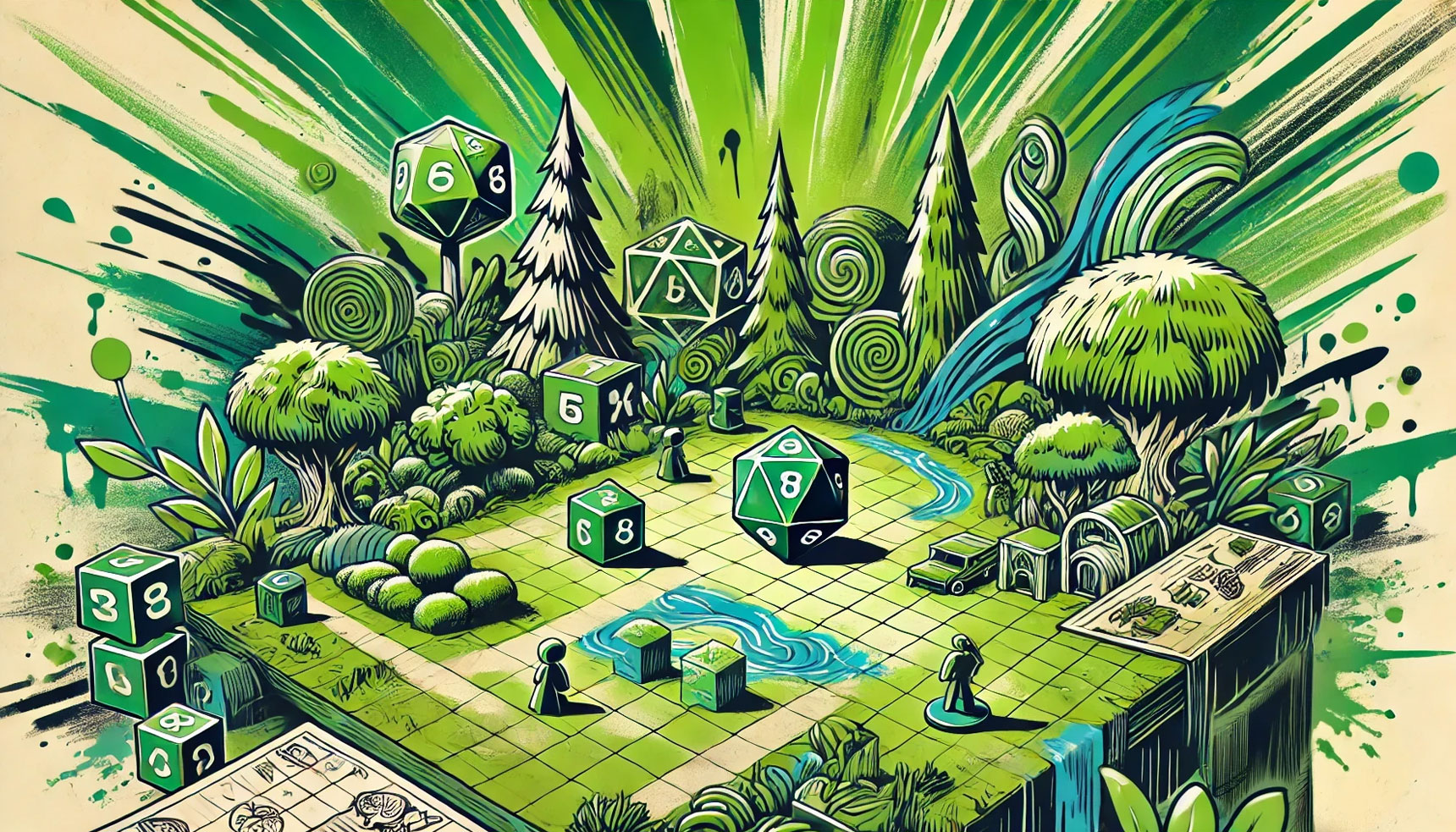Tabletop gaming has long been a hobby of boundless creativity, community and strategy. But as the world becomes more conscious of environmental impact, we must ask: should tabletop and board games be concerned about sustainability? Are these games contributing to ecological harm, or is their impact relatively minor? The reality is complex, with both challenges and opportunities for a more sustainable gaming future.
The Environmental Impact of Tabletop Gaming
Unlike digital entertainment, which consumes energy in ways that are harder to visualise, tabletop gaming involves tangible products. Miniatures, books, dice, and board components, all of which require raw materials and manufacturing. Unsurprisingly, three key tabletop games sustainability concerns include:
- Plastic Miniatures and Accessories: Although some still are metal cast, the majority of miniatures are manufactured from fossil fuel derived plastic or resin. While durable, this does contribute to long term waste.
- Packaging and Production Waste: Some components feature excessive packaging, with plastic inserts, shrink wrap, and additional materials that end up in landfills.
- Manufacturing and Global Shipping: Tabletop products are often commonly batch manufactured in large factories and shipped worldwide. Increasing their carbon footprint while maximising opportunities for wastage.
The Challenge of Resin and 3D Printing
The rise of 3D printing has changed the landscape of miniature production, but it brings its own sustainability challenges. Resin printing for example, while excellent for detail and customisation, uses photopolymer resins that are inherently toxic in liquid form. Even “eco-friendly” water-washable resins contain chemicals that still require responsible handling.
Resin waste is an issue, but it’s not unsolvable. Curing leftover resin before disposal neutralises its toxicity, making it safer for disposal. Print failures are another big factor, every failed print means excess material usage. One way to combat this is through optimised slicing and test printing, ensuring models are dialled in before committing to full production. Some companies are also working on bio-based or partially renewable resins, though they aren’t a perfect solution yet. The challenge isn’t just finding better materials, it’s also about using what we have in a more considered fashion.
How Board Games Fit Into the Discussion
Board games, compared to miniature-heavy TTRPGs, have a stronger sustainability argument. They typically use materials like wood and cardboard, which are more biodegradable and recyclable. Additionally, families and collectors tend to keep them for years, sometimes even decades, reducing their overall environmental impact compared to more disposable consumer goods. Growing up in the early 2000’s most presents came from a Toy Library’s tabletop sales. Pre-loved. As I got older, I returned the favour, bagging them up and putting them back into circulation, further supporting the second-hand market. There is room for manufacturing improvement too, with developers choosing plant-based inks, reducing plastic components and improving supply chain sustainability.
German based Gaiagames have led the way for a decade by developing sustainable and educational board games since 2015. Their focus is not just in their products but also in the overall gameplay experience, utilising natural materials and reducing plastic usage. Stonemaier Games has actively explored the use of renewable inputs and biodegradable outputs to minimise environmental impact, acknowledging the challenges and costs associated with such initiatives. They made a materials switch for Wyrmspan, by swapping out the planned 55 plastic dragon eggs for 55 beautiful wooden ones. These examples highlight a genuine industry trend toward tabletop games sustainability, beyond mere marketing rhetoric. Panda Game Manufacturing manufacture games and components for a range of brands and have been extremely open about their own environmental commitment with a website statement that neatly sums up where we are going with this too – quality and longevity.
“This past year, we have reaffirmed our commitment to reduce single-use plastics and improve the sustainability of our products throughout their lifecycle. Our objective remains to offer our clients and tabletop gamers what they expect from Panda: high-quality games that will delight players for many years. We believe that this objective can be achieved while also considerably reducing the impact that our games have on the environment.”
Modular Miniatures & Responsible Consumption
One way to rethink sustainability in TTRPGs is by considering how miniatures and accessories are designed and used. Instead of constantly buying new models, what if miniatures were designed with modular intent in mind, allowing for customisability and reuse. While challenging due to scale, some companies have experimented with swappable weapons and accessories. The term modular doesn’t necessarily need a respond in the form physical applications. This could also refer to flexible modular schemes – multi army miniatures, less confined to one singular sect and fully embracing user generated kitbash characterisation.
Another important factor is responsible consumption – buying fewer, high-quality pieces rather than vast quantities of mass-produced ones. The second-hand market for miniatures is thriving, and companies could do more to support resale, repainting, and recycling efforts.
What Anarky Creations is Doing
At Anarky Creations, we are conscious of the environmental concerns surrounding resin-based 3D printing and have taken steps to operate more sustainably:
- Print on Demand: We only produce what is ordered, minimising overproduction and waste.
- Sustainable Packaging: We reuse materials such as cardboard boxes, brown paper from Amazon parcels, and bubble wrap sourced from solar panel packaging waste.
- Waste Curing: All resin waste is cured in sunlight before disposal to ensure it is inert.
- Optimised Printing Processes: Our slicing and file preparation methods aim to reduce material waste.
- Prototyping: Test prints help minimise failed prints on a large scale. A full print-bed fail is extremely rare.
- Continuous Material Research: We are always looking for better, greener resins.
- Responsible Disposal: We take care in how we dispose of hazardous materials, ensuring minimal environmental impact.
How Hobbyists Can Contribute to Sustainability
Sustainability isn’t just about what manufacturers do it’s also about the choices we as hobbyists make. Here are some ways players can reduce their environmental impact while still enjoying the hobby:
- Buy Smart, Not Fast: Instead of impulse-buying every new release, hobbyists can curate their collections by focusing on versatile, high-quality miniatures and terrain.
- Support Second-Hand Markets: Buying and selling used miniatures, repainting old models, and trading terrain within gaming communities extends product life and reduces waste.
- Choose Eco-Friendly Hobby Supplies: High-quality synthetic brushes last longer, reducing the need for frequent replacements. Using natural sand, crushed stone, or repurposed craft materials for basing is more sustainable than plastic flock.
- Kitbashing Over Buying More: Instead of purchasing new miniatures for every unit variation, hobbyists can modify existing models using leftover bits, sculpting putty, or parts from old projects.
The Future of Sustainability in Tabletop Gaming
The industry is evolving, and tabletop games sustainability is becoming a greater priority. Some resin manufacturers are now offering eco-conscious alternatives:
- 3Dresyns: Develops safe bio-based and synthetic biocompatible multifunctional photopolymer 3D resins bio-based resins with high renewable content.
- Siraya Tech: Offers plant-based resins with lower environmental impact.
As players and manufacturers, we have the power to shape the industry’s future. The solution isn’t just waiting for a perfect “green” material, although that would be nice, it’s about making better choices at every stage. From design and manufacturing to how we, as hobbyists, consume and reuse our gaming materials. Quality, longevity and informed purchasing are key.
Can the industry balance sustainability with creativity? Can manufacturers innovate while still allowing players to build and expand their armies? These are the challenges that will define the future of TTRPG sustainability.
Join the Conversation
Sustainability in tabletop gaming is an evolving conversation, and we’d love to hear your thoughts. What changes would you like to see in the industry? How do you balance your love for the hobby with environmental responsibility? Share your insights in the comments or join us on social media to continue the discussion!

